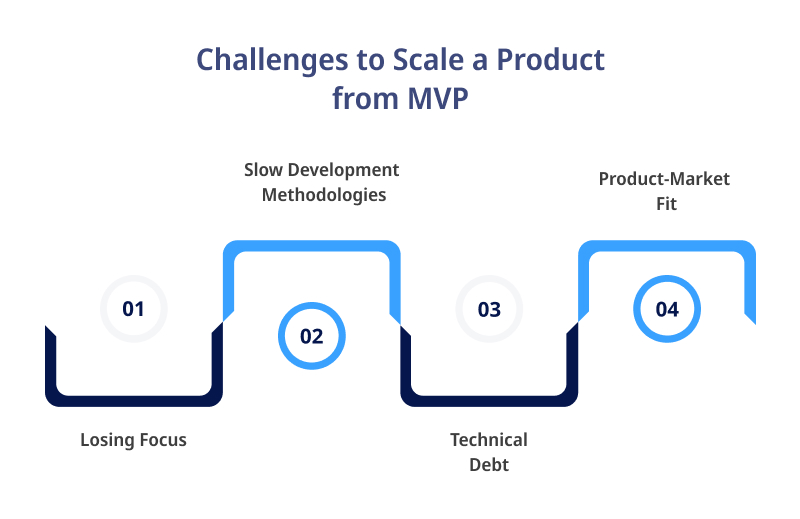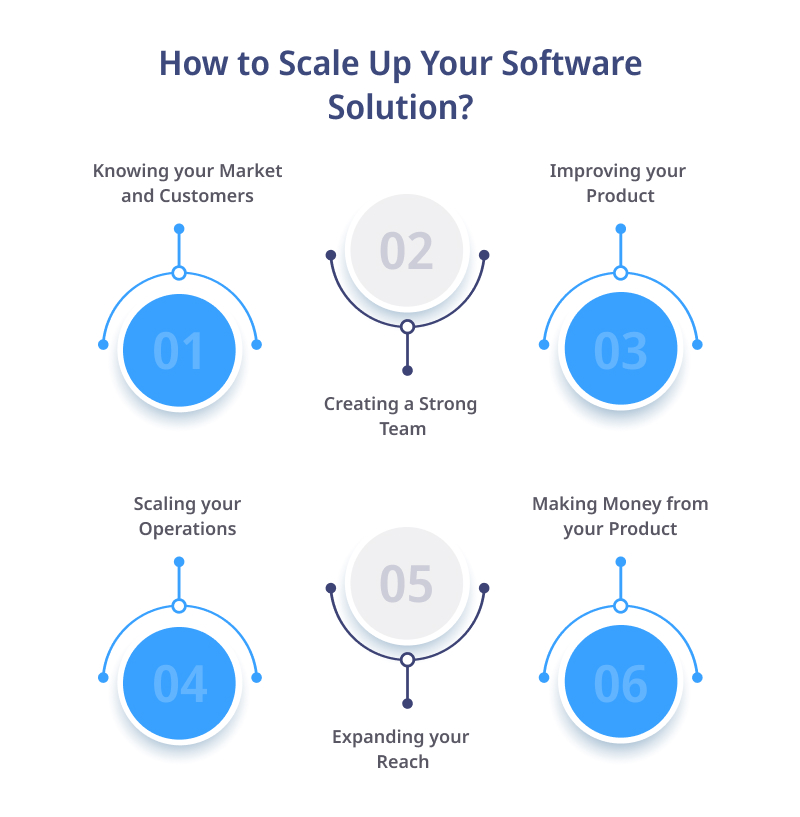Scaling a software solution from a humble Minimum Viable Product (MVP) to a full-fledged powerhouse product is no easy feat.
While the initial MVP software development may have been successful, it is crucial to adapt and improve it to meet evolving customer needs, market trends, and business objectives.
All it needs is a strategic approach to transition from an MVP to a scalable end product. You need to take a myriad of factors into account, including cutting-edge technology, unparalleled user experience, market demands, and budget constraints.
In this blog post, we dive deeper into the matter and unveil the strategies that will help you scale the MVP into an ROI-centric product.

Table of Contents
Why is MVP Important?
As per a study, 50% of startups fail during the first five years and 22% fail in their first year. Only the rest of the 28% of startups experience sustained success. To be in 28%, you must implement an MVP strategy for your business.
With the help of an MVP, you may confirm user interest in your product. Positive MVP phase outcomes offer the go-ahead for full version development. Developing and evaluating a minimal viable product enables you to:
- Ensure you’re investing in a project with a good chance of succeeding to save time and resources.
- Verify whether potential customers would find the product appealing.
- Find out which trends you may use to your benefit while creating the product’s full version.
- Find early adopters and gather a base of potential users.
- Save money and time when creating the finished product.
- Attract investors sooner
Updating from an MVP to a full-fledged product is necessary because:
- MVP might not have some critical features.
- MVP might lack in strengthening the performance of the solution.
- MVPs may lack the polished user experience found in more mature products.
- Scaling the product to handle larger user bases or increased data volumes may not be a primary focus in the MVP stage.
- MVPs may not undergo extensive testing for all possible scenarios or edge cases.
- MVP may need more advanced analytics capabilities and detailed reporting in the initial stages.
Let our team design help transform your MVP into a full-fledged product.
Challenges to Scale a Product from MVP
Scaling a product from the MVP software development stage to a larger scale comes with challenges. It is essential to address these challenges to grow and expand the product effectively. Some key challenges to consider are:
Losing Focus: As a business grows and expands, it can be challenging to ensure that all parties, including employees and stakeholders, agree with the product strategy. It is common for new employees to have different perspectives and understanding of the company’s vision for the product. In these circumstances, the product team is responsible for addressing and resolving any disagreements to ensure everyone is on the same page.
Slow Development Methodologies: These refers to the challenges posed by traditional or outdated approaches to product development that are time-consuming and inefficient when scaling a product from an MVP.
These methodologies typically involve lengthy planning phases, extensive documentation, and sequential processes that can hinder the ability to iterate and make quick improvements based on user feedback. It can impede progress and make it difficult to stay on top of the changing requirements of the product and its users.
Scaling a product from MVP requires agility, adaptability, and the ability to respond rapidly to changing market demands. The MVP development process must adapt as firms expand and the development team grows.
Technical Debt: Technical debt is the accumulation of inefficient code, design, or infrastructure choices made during the development process of a product. It can become a significant challenge when scaling a product from an MVP. As the product grows and evolves, the shortcuts taken or trade-offs made in the initial development phase may hinder future scalability, performance, and maintainability.
It can result in increased development time, decreased productivity, and higher costs to address and fix the accumulated issues. It is important to actively manage and prioritize addressing technical debt to ensure the long-term success and scalability of the product.
Product-Market Fit: The difficulty in achieving product-market fit increases as a product grows in scale. A product may not appeal to a bigger, more diversified audience if it only appeals to a few early adopters. As a result, carrying out extra market research and consumer validation is crucial.
How to Scale Up Your Software Solution?
Scaling up a software solution can be challenging and requires careful planning and execution. Here are some key strategies for scaling your software solution:
-
Knowing Your Market and Customers
You must first comprehend your market and clients to scale your MVP effectively. It involves research, analysis, and a readiness for criticism.
Start by looking at your target audience’s demands, behaviors, and demographics. This data will assist you in deciding the direction of your product and the features to put in first.
Next, pinpoint market possibilities and pain points. What problems does your product solve, and how can it improve? You may use this information to plan your product roadmap and stay one step ahead of the competition.
If you comprehend the market and location, you may make data-driven judgments about your product strategy and growth. Then, investigate market trends and your rivals’ strategies. What do they do well, and how can you differentiate yourself?
-
Creating a Strong Team
Scaling your MVP involves creating a fantastic team. It requires making the right hiring decisions, outlining precise roles and responsibilities, and fostering a creative and collaborative work environment.
To build a high-quality product, you must build a strong team. Look for candidates with a history of success and familiarity with software development.
Once your team is in place, clearly define roles and duties. It will ensure that everyone is collaborating effectively and prevent misunderstandings.
Finally, promote a culture of cooperation and innovation. Encourage cooperation and share ideas with your team. As a result, the candidates will stay creative and keep you ahead of the competition.
-
Improving Your Product
Once your team is in place, you may focus on enhancing your product. To stay ahead of the competition, you must evaluate feedback and make improvements based on consumer feedback.
To get direct feedback on your product, conduct user testing from actual users. It will help you find opportunities for improvement and make decisions regarding the future of your product. Implement adjustments in response to customer feedback, then monitor their success. By doing this, you’ll be able to continuously improve your product and keep it at the top of the market.
-
Scaling Your Operations
After the product is polished, you should focus on expanding your business. It involves streamlining procedures, building trusting connections with clients and suppliers, and utilizing cutting-edge technology to speed up business processes.
You can work more productively and save time by automating processes. Use customer relationship management (CRM), project management, and task management software for automation.
You may scale your business with the help of strong relationships you build with suppliers and vendors. Find partners who support your goals and share your ideas.
Next, deploy cutting-edge technologies such as machine learning, artificial intelligence, and blockchain technology to streamline your operations.
-
Expanding Your Reach
You must create an effective marketing strategy and build a solid web presence to attract new customers and expand your reach. It includes utilizing social media, SEO, and content marketing.
Create a strong marketing plan that speaks to your target market and conveys the benefits of your product. It includes influencer marketing, email marketing, and paid advertising.
To have a strong online presence, you can use social media platforms like Twitter, Facebook, and Instagram to engage with your target market while promoting your items with engaging content. With all of it, you can expand your user base through affiliate and referral networks.
-
Making Money from Your Product
The final step in scaling your MVP includes monetizing your product. It includes evaluating your income model, implementing successful monetization strategies, and keeping up with trends.
Examine your revenue model to ensure it reflects customer needs and business goals. As monetization strategies, think about freemium models, subscription-based models, and advertising-based approaches.
You can use monetization strategies that suit your target market and align with your goals. You can monetize your product by adding new features, creating a paid edition, or advertising.
However, stay updated with new monetization trends. Keep up with market developments and look into novel and creative monetization strategies to maintain your competitive edge and maximize your revenue potential.
Examples of Companies Started With MVPs
Here are 3 examples of companies that used MVP development services:
-
Copyblogger
Copyblogger is a digital marketing company that began with a simple blog as its minimum viable product (MVP). The founder, Brian Clark, started the blog in 2006 to share his copywriting and content marketing expertise.
Clark used reader comments to hone and improve the blog’s content as it grew in popularity, eventually branching out into other services, including software and online courses. Today, Copyblogger is the world’s largest digital marketing platform, with millions of users and customers.
-
Dropbox
Dropbox is a cloud-based file-sharing and storage service launched in 2007 as an MVP. The product’s creators, Drew Houston, and Arash Ferdowsi, uploaded a video on a tech forum to measure interest. The feedback was incredibly favorable, so they immediately created a landing page and started gathering potential customers’ email addresses.
It assisted them in obtaining money and advancing the product’s development, which ultimately saw a 2008 public release. With millions of users worldwide, Dropbox is one of the most widely used file-sharing platforms.
-
Zappos
Zappos is an online shoe and clothes business founded as an MVP in 1999. The founder, Nick Swinmurn, developed a simple website using images and descriptions from other shops’ websites to sell shoes online.
Although orders had to be still placed with the actual stores, the site was partially functioning, giving Swinmurn a chance to get consumer feedback. The site was later developed into a fully functional online store with its inventory and warehouse using the input it received from users.
Today, with millions of customers and billions in annual revenue, Zappos is among the biggest online shoe retailers in the world.
How Can PixelCrayons Help You in Scaling Your Software Solution?
PixelCrayons is a software development firm that offers many ways for companies to scale their software solutions. We have skilled developers who can assist companies in improving their current software products and guaranteeing that they are optimized for usability, performance, and scalability.
We also help companies create new software features and solutions that enable them to grow their customer base and create new revenue streams. They can collaborate with other organizations to find potential growth areas, create specialized software solutions tailored to their particular requirements, and offer continuous support and maintenance to keep the software current and competitive.
If you want to grow your product, connect with us to experience our custom software development services.
Wrapping Up
Scaling your MVP involves strategic planning, product improvement, operational effectiveness, and efficient monetization. Use these strategies to expand your product beyond its original launch, attract more users, and boost your revenue potential.
Remember that growing your MVP is a journey rather than a final destination. Keep your focus, be receptive to criticism, and always iterate and improve.
If you adopt the right plan and enroll right software product development services, you can develop your product and do an excellent job.
Contact our team of experts to transform your MVP into a high-performing product.
Frequently Asked Questions
What is MVP in software development?
A minimum Viable Product is a version with limited features needed to test its viability and gather customer input in software development. An MVP aims to test the market and validate the assumptions established about the product’s potential demand and usability with a fully-featured product that will be developed based on consumer input and market demand.
What is an MVP in Agile?
MVP in agile development is a lean product development method that emphasizes building a product with the bare minimum of features necessary to satisfy the customer’s needs. The MVP is often built in quick iterations, each concentrating on a specific set of features judged essential to the product’s success.
What are the 3 elements of MVP?
There are 3 elements of MVP development for enterprises:
- Viability: The product should be able to survive on the market, which means that there may be a demand for it and that there may be a market for it.
- Usability: A product should be useable if it offers the user value and is simple.
- Feasibility: The product should be developed in a reasonable time and cost.
What is MVP in software testing?
It refers to the minimum features that must be present for a product to be deemed valuable for testing. When testing software, the MVP approach is used to confirm that the product works as intended, spot any severe flaws or problems, and offer suggestions for improvement to the development team.
Software testing’s MVP ensures that the finished product fulfills the required quality standards and is a crucial phase in the software development lifecycle.








